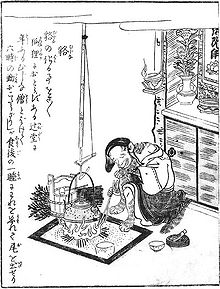Mujina
Mujina ( Jap. 貉 ; dt. "Roof") is the name of a fictitious nature of Japanese popular belief that the transformation competent Yōkai described and as proverbial Frechdachs is illustrated. Another name for the being is Kabukirikozō ( か ぶ き り 小僧 ).
description
The mujina is usually described as an anthropomorphic badger-human creature who, according to legend, likes to and often changes shape in order to deceive unsuspecting hikers or to entice them to gamble . Often he is supposed to take on the form of a monk in order to then sing for alms and thus to chur off money or a substantial meal from the deceived. In other cases, he is said to be napping somewhere on dirt roads or in entrances to temples and shrines in the form of a monk or beggar and blocking people's path. No matter how often you try to wake him up, it either turns out to be useless or he falls asleep again immediately. However, the Mujina should not always benefit from the fact that he likes to sleep: when he is asleep, his transformative charm would often subside and his bushy badger tail would appear.
The ability of a Mujina to transform into an apparently human being without a face, especially a faceless monk ( の っ ぺ ら ぼ う , Noppera-bō ) is also very well known .
backgrounds
The Japanese word mujina actually refers to the animal species Japanese badger (Meles anakuma) , which is also known regionally in Japan as Anaguma (Japanese 穴 熊 ). According to Japanese folklore, the mythological Mujina, on the other hand, is very close to the Tanuki , another yōkai capable of transformation. It is not uncommon for both beings to be confused with one another, both by name and mythologically, because their abilities and behaviors are said to be very similar. One of the earliest mentions of Mujina appeared around 720 in the work Nihonshoki / Nihongi (Japanese 日本 紀 , Eng. "Chronicle of Japan"; published by Prince Toneri-shinnō ). There the creature is mentioned in two places, on the one hand in the description for the year 58, in which it is reported that the dog of a man named Mika-so bitten to death a Mujina, in whose stomach a valuable jewel was found. The jewel had been given to the Tennō and was kept in the Ise shrine . The second apparition is narrated for the year 627: A mujina appeared in the province of Michinoku , turned into a person and sang.
The scholar and author Toriyama Sekien (1712-1788) describes the Mujina in his famous work Konjaku Gazu Zoku Hyakki (Jap. 今昔画図続百鬼 dt "Illustrated parade of one hundred. Demons past and present") as a gifted Trickster , the returns to his treacherous animal form after eating and nodding off. Sekien also points out Mujina's similarity to the Tanuki and also compares Mujina's abilities with those of the Kitsune .
In his story Mujina from 1904, Lafcadio Hearn describes a Mujina in the form of a bitterly weeping young woman who frightens the protagonist (a helpful and gullible trader from Kyobashi ): when the man speaks to the woman to comfort her, she turns turns around and reveals that she has no face at all.
See also
- Tanuki : Aquick-changeartist and yōkai in the form of araccoon dog who allegedly likes to fool people and then portray them as stupid.
- Kitsune : Another quick-change artist and yōkai in the form of a multi-tailed ice fox , which supposedlybringspeople luck and bad luck.
- Obake : Collective term for traditional ghosts , goblins and monsters of Japanese folk belief.
literature
- Robert B. Durham: Modern Folklore. Lulu Press Inc., Raleigh (North Carolina) 2015, ISBN 9781312909694 , p. 286.
- Michael Dylan Foster : The Book of Yokai: Mysterious Creatures of Japanese Folklore . University of California Press, Berkeley 2015, ISBN 0520271017 .
- Hiroko Yoda, Matt Alt: Japandemonium Illustrated: The Yokai Encyclopedias of Toriyama Sekien . Courier Dover Publications, Mineola (New York) 2015, ISBN 0486818756 .
- Lafcadio Hearn : Kwaidan: Ghost Stories and Strange Tales of Old Japan . With an introduction by Oscar Lewis , Dover Publications, Mineola (New York) 2012 (new edition), ISBN 0486120929
Web links
- Background information on the Mujina at yokai.com (English).
- Lafcadio Hearn's story of Mujina in his work Kwaidan (1904) on trussel.com (English).
Individual evidence
- ↑ Illustrated database of Japanese yokai: Mujina on yokai.com (English); last accessed on May 24, 2018.
- ↑ Michael Dylan Foster: Haunting Modernity. Tanuki, Trains, and Transformation in Japan. In: Asian Ethnology. Vol. 71, No. 1, 2012, ISSN 1882-6865 , pp. 3-29, here p. 23, JSTOR 41551381 .
- ↑ Karl Florenz: The historical sources of the Shinto religion. Translated and explained from Old Japanese and Chinese. Vandenhoeck & Rupprecht, Göttingen 1919, p. 266
- ↑ Karl Florenz: The historical sources of the Shinto religion. Translated and explained from Old Japanese and Chinese. Vandenhoeck & Rupprecht, Göttingen 1919, p. 331, online
- ↑ Michael Dylan Foster: The Book of Yokai: Mysterious Creatures of Japanese Folklore , pp. 193 & 194.
- ↑ Hiroko Yoda, Matt Alt: Japandemonium Illustrated: The Yokai Encyclopedias of Toriyama Sekien , 136.
- ^ Lafcadio Hearn, Oscar Lewis (ed.): Kwaidan: Ghost Stories and Strange Tales of Old Japan . P. 51 & 52. ( Google Books digitized version )
